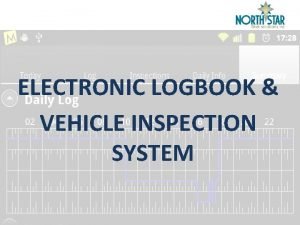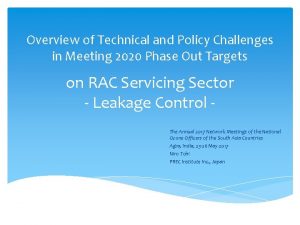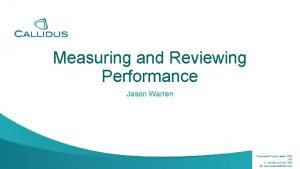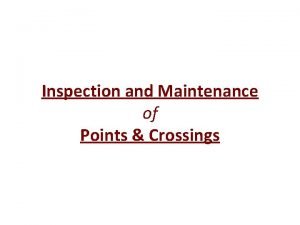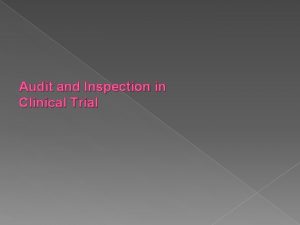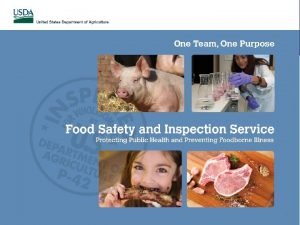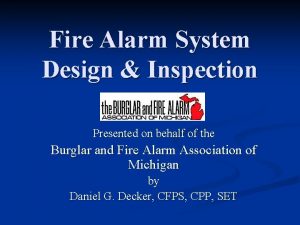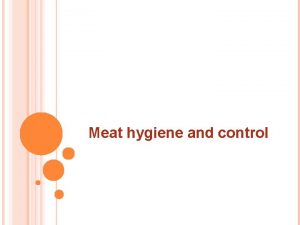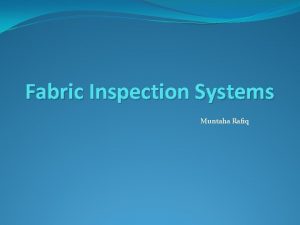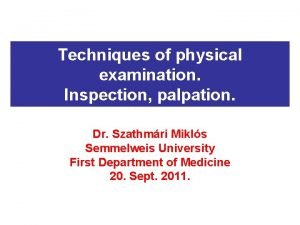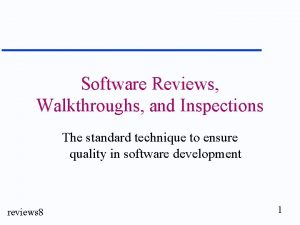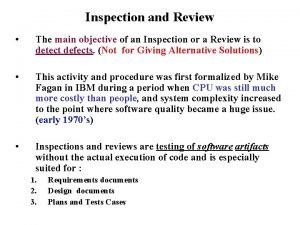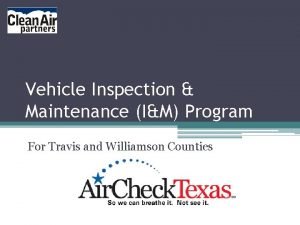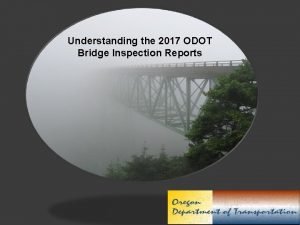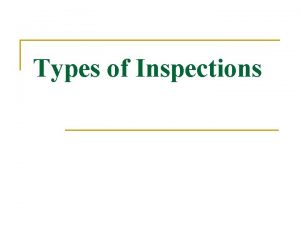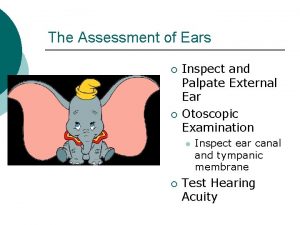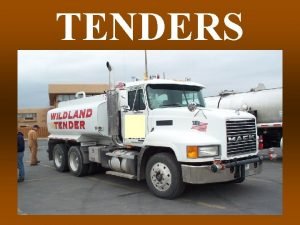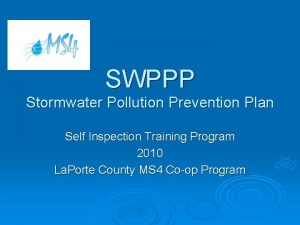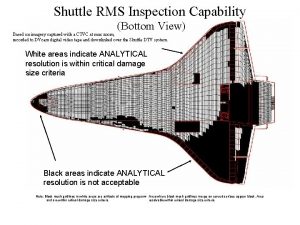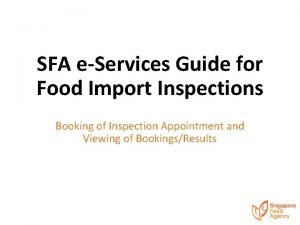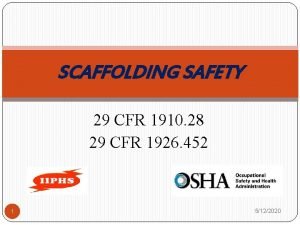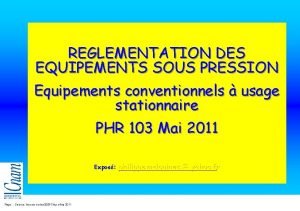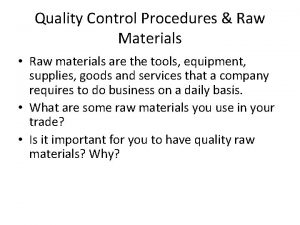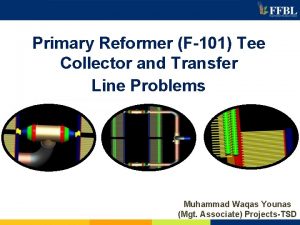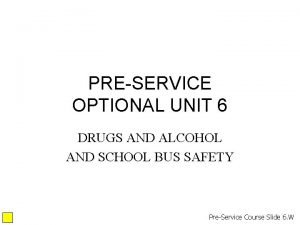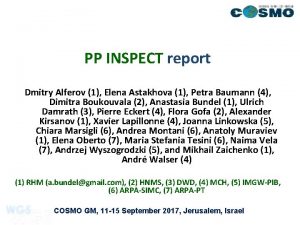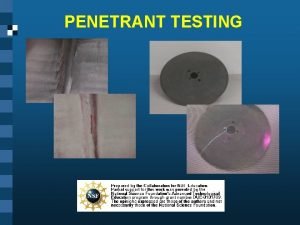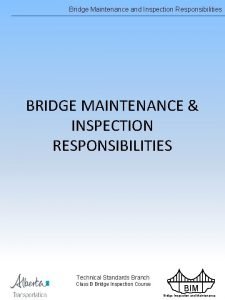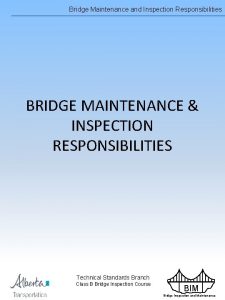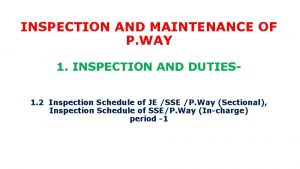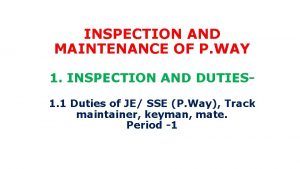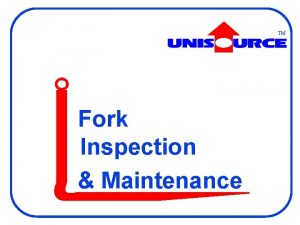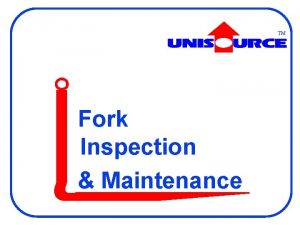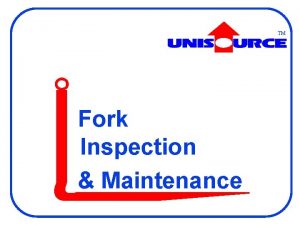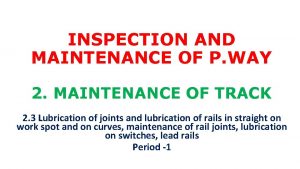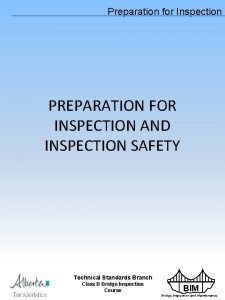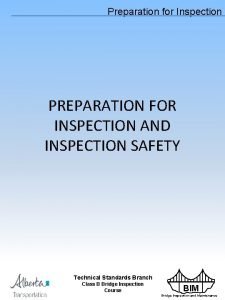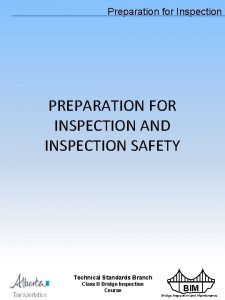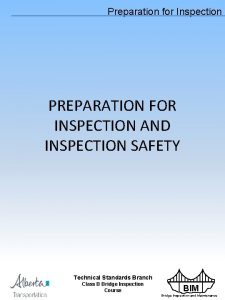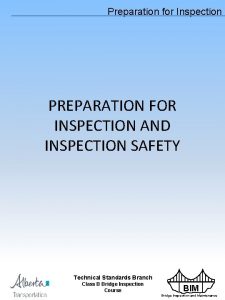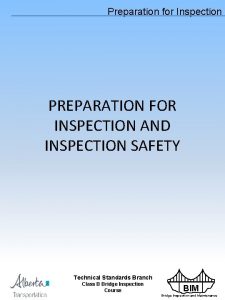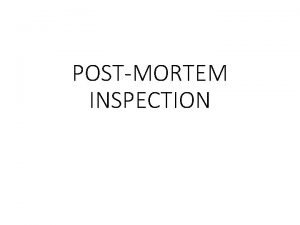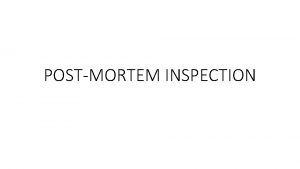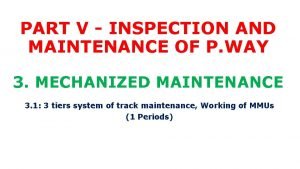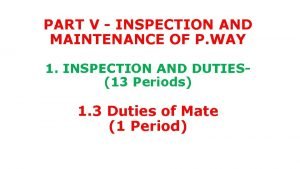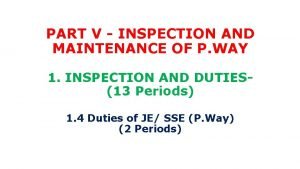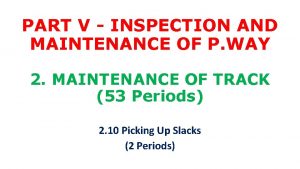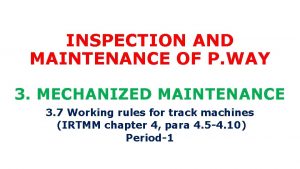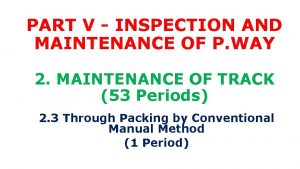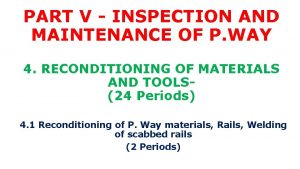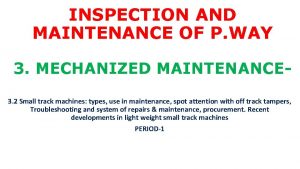INSPECTION AND MAINTENANCE OF P WAY 2 MAINTENANCE


























































- Slides: 58

INSPECTION AND MAINTENANCE OF P. WAY 2. MAINTENANCE OF TRACK 2. 1 Annual Programme of Track Maintenance, Through packing, overhauling, picking of slacks, lifting and lowering of track, deep screenuing of ballast, importance of track drainage. Inspection of cutting, removal of loose boulders period -1

Annual Programme of Track Maintenance: • The annual machine deployment programme shall be issued by CTE for track renewal, rail grinding, deep screening and shoulder screening machines based on yearly requirement of track maintenance. • For other machines, the deployment programme shall be decided by Sr. DEN / Co which will be periodically reviewed based on TRC results and Para 523 of IRPWM.

Annual Programme of Track Maintenance: • Field engineers will also make annual (two half-yearly, first: April to September and second: October to March) programme of regular track maintenance and works incidental thereto which shall be consistent with annual machine deployment programme. • The annual programme of regular track maintenance and works incidental thereto may be followed for guidance is given in next slide:



Through Packing Method: - by Conventional Manual • Normally manual through packing is not to be done in concrete sleeper track. • However, in locations of slacks where multipurpose tampers are not available, following steps in sequence shall be followed.

Through Packing by Conventional Manual Method: • The length of track opened out on any one day shall not be more than that can be efficiently tackled before the end of the day– (a) Opening of the road. (b) Examination of rails, sleepers and fastenings. (c) Squaring of sleepers. (d) Slewing of track to correct alignment.

Through Packing by Conventional Manual Method: (e) Gauging. (f) Packing of sleepers. (g) Repacking of joint sleepers. (h) Boxing of ballast section and tidying.

• The details of various steps listed above is given in Annexure - 6/9 of IRPWM. The provisions of Part D of Chapter 3 of IRPWM should be followed, wherever through packing is being done in LWR/CWR track. • Appropriate small track machines should be deployed instead of conventional tools for carrying out various operations, wherever feasible.

Details of the 8 operations of Systematic Through Packing are as detailed below– 1. Opening of Road– • Ballast should be opened out on either side of the rail seats to the extent from end of sleepers to 450 mm inside of the rail seat to a depth of 50 mm below the packing surface without disturbing the cores under the sleepers.

Details of the 8 operations of Systematic Through Packing are as detailed below– 1. Opening of Road– • The ballast should be drawn by phowrahs/ shovels or rake iron ballast outwards and inwards i. e. that portion of the ballast on the outside of the rail should be drawn outwards, the portions between the rails being drawn towards the centre, care however, should be taken to see that the ridge between the rails does not project more than 50 mm above rail level.

2. Examination of Rails, Sleepers and Fastenings– (i) Rails should be examined, the underside for corrosion, the ends for cracks, the head for top and side wear, rail joints for wear on the fishing planes, fish bolts for tightness. 1) If rails on curves wear at an unusually rapid rate, lubrication of the gauge face should be done. 2) Rust and dust must be removed from the corroded rails by using wire brushes. 3) Kinks in rails should be removed by Jim crowing.

2. Examination of Rails, Sleepers and Fastenings– (ii) Sleepers should be inspected for their condition and soundness particularly at the rail seats. (iii) Fastenings and fittings should be examined to ensure that they are in good order, appropriately tightened so that they firmly hold the rails. Broken ones should be replaced immediately.

3. Squaring of sleepers– Gauge variations and kinks inevitably result from sleepers getting out of square, therefore the spacing of sleepers on the sighting rail should first be checked and correctly chalk – marked. Corresponding marks should then be made on the other rail using the square at every point. The core of sleepers that are out-of-square should then be ‘picked’ with the pick ends of beaters, the fastenings loosened and the sleepers levered and squared to correct position.

3. Squaring of sleepers– Squaring should be done by using mechanical/hydraulic spacer or by planting the crow bars firmly against the sleeper and pushing it. Under no circumstances should sleepers be hammered. Sleepers that are squared should be re-gauged immediately, the fastenings tightened and repacked.

4. Slewing of track to correct alignment– (i) Heavy slewing will only be required during realignment of curves when it will be necessary to loosen the rail, joints and the packing cores being broken with the pick-ends of beaters. Slewing for normal maintenance will be of a small order and should be done after opening out the road, loosening the cores at ends and drawing out sufficient ballast at the ends of the sleepers. (ii) Slewing of track shall be directed by the Mate, who should sight the rail from a distance of 30 to 60 meters on straight track. On curves, the Gang Mate should sight the outer rail.

4. Slewing of track to correct alignment– (iii) Slewing is best done in the morning unless it is cloudy, as later on, sighting conditions become unfavourable. (iv) Slewing should preferably be done using hydraulic/mechanical jacks or TRALIS. If crow bars are used, these should be planted well into the ballast at an angle not more than 30 degrees from the vertical; otherwise lifting of the track may occur.

5. Gauging– (i) Preservation of gauge is an important part of track maintenance especially through points and crossings. For good riding, the basic requirement is uniform gauge over a continuous stretch of track and such gauge should be allowed to continue so long as it is within the permissible limits of tightness or slackness. (ii) Gauging should only be done after ensuring that sleepers are truly square.

5. Gauging– (iii) The track gauge cum level should be held firm with one lug against the base rail, and the other end being swivelled over the opposite rails. The tightest position obtained determines the correct point to test the gauge. The gauge cum level should not be forced as that causes considerable wear on the gauge lug. (iv) While it is desirable to maintain correct gauge, it may not be possible to maintain correct gauge due to wear in rail and sleeper inserts. It is good practice to work within the tolerances of gauge, as specified in Para 525 (1) of IRPWM, provided generally uniform gauge can be maintained over long lengths.

6. Packing of sleepers– (i) The aim of packing is to have each sleeper firmly and uniformly packed to ensure that the rails are at their correct relative levels i. e. , level on the straight track and to the required cant on curves and that no sleeper has any void between it and its bed. (ii) Before packing is commenced, it is necessary to ensure that all the fittings are intact. Wherever feasible packing is to be done by worksite tampers. However, if worksite tampers are not available, manual packing as detailed below may be done.

6. Packing of sleepers– (iii) The Gang Mate shall sight the base rail with eye along the lower edge of the head of rail and any dip or low joint lifted correctly. The adjacent sleepers should then be packed and the top checked. After two rail lengths have been attended to, the rail on the other side should be brought to the correct level by checking cross level with the gauge-cum-level at every rail joint and at every fourth sleeper. The next two rail lengths should then be taken up and the process continued. (iv) No joint or dip should be lifted higher than the proper level in the expectation that it will settle to the correct level. Instead it will settle more under traffic as a result of being high and cause rough running.

6. Packing of sleepers– (v) Having aligned the track and the rail table adjusted, Track Maintainers should be distributed in batches of two for packing all sleepers in a systematic manner, commencing from one end. Four men should deal with every sleeper successively, two at each rail seat. The ballast under the sleeper should be packed by the men standing back-to-back and working their off track hand held tampers diagonally under the rail seat at the same time to ensure firm packing. Where off track hand held tampers are not available the packing can be done by crowbars / straightening bars. (vi) While using crowbars, it is important that the cores are thoroughly broken before packing and re-packed.

6. Packing of sleepers– (vii) After packing the rail seat, the packing should be continued outwards and inwards to the requisite extent on each side of the rail seat i. e. , end of the sleeper to 450 mm inside, the strokes being kept as nearly horizontal as possible. Care must be taken to avoid forcing any large stone under the sleeper so as not to cause uneven bearing and to avoid striking the edges of the sleepers. All men should aim to work the crowbars from the same height so that the sleepers are uniformly packed. Higher or lower lifting of the crowbars results in uneven compactness.

6. Packing of sleepers– (viii) Before final dressing is done, it should be ensured that no sleeper is centre-bound by working the pick-ends over the central range. Centre bound sleepers cause vehicles to roll from side to side. (ix) Care must also be taken while packing to ensure that the work does not result in the sleepers adjoining those being packed, lifted off their bed, thus creating artificial voids under them.

6. Packing of sleepers– (x) The packing on the inside and outside at every rail seat should, before boxing the track, be checked by the Gang Mate by tapping with a rubberised Canne-a boule. An inadequate rebound would indicate defective packing, which should be attended to again. (xi) As soon as the packing is completed, slight distortions in alignment and top should be checked and corrected by the Mate, the sleeper disturbed for this purpose being finally repacked.

7. Repacking of joint sleepers– The joint and ‘shoulder’ sleepers should be repacked, before boxing is done and the cross- levels at joints checked. The rail joint being the weakest portion, firmness of its support is essential.

8. Boxing of Ballast section and Tidying– (i) After completing the preceding operations in sequence, clean ballast should be worked in with ballast forks or rakes. The ballast section should be dressed to the specified dimensions, a template being used for the purpose. Hemp cords 6 mm dia. of sufficient length should be used for lining the top and bottom edges of the ballast section. Where the quantity of ballast is inadequate, full section of ballast should be provided near the rail seat, the deficiency being reflected along the centre of the track and not under the rails or in the shoulders.

8. Boxing of Ballast section and Tidying– (ii) The cess should then be tidied up. (iii) Where earth ridging exists at the edge of the bank, it should be removed. (iv) Cess should be maintained to the correct depth below rail level according to the ballast-section and formation profile. Too high a cess affects drainage; too low a cess results in ballast-spread and wastage.

Systematic Overhauling: The length of the section to be overhauled shall be such that complete overhauling of track will be accomplished within a specific period (normally 3 to 5 years). The overhauling should be done using SBCM for cleaning of shoulder ballast. The crib ballast should also be shifted to shoulders for screening by the machine, which should again be put back in crib portion. In case it is not feasible to screen the crib ballast by machine, the same should be screened manually. Adequate care should be taken in removing the crib ballast in LWR/CWR track. All the loop lines should be shallow screened/overhauled once in 7 years or more frequently as required, along with systematic tamping/packing.

Systematic Overhauling: (1) Sequence of operations– Overhauling consists of the following operations in sequence– (a) Shallow screening and making up of ballast. (b) All items attended to, while doing through packing as detailed in Para 607 of IRPWM. (c) Making up the cess.

(2) Shallow Screening and making up of Ballast– (a) For good drainage periodical screening of ballast is essential. (b) In case of manual overhauling, the crib ballast in the shoulders should be opened out to a depth of 75 to 100 mm below the bottom of sleepers, sloping from the centre towards sleeper end. The ballast in the shoulders opposite to the crib as well as between the sleepers is removed to the full depth. A slope is given at the bottom sloping away from the sleeper end. The ballast is then screened and put back. Care should be taken to see that the packing under the sleepers is not disturbed and the muck removed is not allowed to raise the cess above the correct level.

(2) Shallow Screening and making up of Ballast– (c) Two contiguous spaces between sleepers should not be worked at the same time. (d) Screening should be progressed in alternate panels of one rail length. In no circumstances should several rail lengths of track be stripped of ballast simultaneously.

(e) Where drains across the track exist, they should be cleaned and filled with boulders or ballast to prevent packing from working out and forming slacks. (f) After screening, full ballast section should be provided, extra ballast being run out in advance for the purpose. Work should be commenced after making sure that the ballast will not be seriously deficient. Deficiency, if any, should be shown in the central portion of sleeper and this also should be made up soon.

(3) Through packing of track – The detailed operations are described in Para 607 of IRPWM. Through packing may be done preferably by using machines and in unavoidable situations by conventional beater packing.

(4) Making up of Cess– Cess when high should be cut along with overhauling and when low should be made up. A template should be used for this purpose. (5) Overhauling should be completed before the end of March.

(6) Overhauling of SWR/LWR/CWR track– In such cases the relevant provisions detailed in Para 324 & 345 of IRPWM should be followed.

Picking Up Slacks: (1)Slacks usually occur on stretches of yielding formation, on high banks and cuttings, on approaches of bridges, LC approaches, SEJs, P&C zones, Glued Joints, on badly aligned curves, axle counter locations and other electrical and S&T installations where ballast is poor in quality or quantity or where drainage is defective. (2)Need for attention to slacks is determined by inspections and results of track recording car and OMS/Oscillograph car.

Picking Up Slacks: 3) The locations needing urgent maintenance as detected by TRC/OMS shall be targeted first for restoring normal condition quickly and thereafter the locations identified for Need Based Maintenance as determined by Track recording Car or other inspections shall be attended. 4) For spot attention/slack picking, multi- purpose Tampers and Off-track hand held tampers/ any other approved equipment shall be used as a regular measure. 5) For Off-track tampers, the working instructions, issued by Railway Board/RDSO should be followed. As an interim measure, where Off-track tampers are not available, packing may be done with the help of Crowbar/Beater, duly taking care that concrete sleepers are not damaged.

• The quantum of work turned out by a gang during the day will depend on the extent of slacks. In all cases, sighting is done, the defects assessed and marks made with chalk on sleepers to be attended. • The marked sleepers should then be dealt with as in through packing as given in Para 607 of IRPWM, care being taken to see that the packing of adjacent sleepers does not get disturbed.

• In case a large percentage of sleepers needs attention in a rail length, the entire rail length should be attended to. The marking of defects shall be as indicated below:

(6) In the case of a low joint, the fishplates should be slightly loosened and the joint tapped, so that the rail ends are, rendered free and are capable of being lifted. (7) After the joint is thoroughly packed the fishplates should be tightened again. When joints are picked up, at least three sleepers on either side of the joints should be packed. (8) If the length of track marked for need based maintenance is more in a Kilometer then this should be attended by on track Machine

Mannual deep screening










Manual Deep Screening

Manual Deep Screening

BALLAST CLEANING MACHINE (DEALT SEPERATELY IN MECHANISED MAINTENANCE)

Side and Catch Water Drains and Waterways: (1) For efficient drainage of cuttings, side and catch water drains of suitable type and size should be provided. The bottom of side drains should be at least 30 cm below the formation level. (2) Adequate openings to take the full flow of side drains should be provided under level crossings where they exist in or at the end of the cuttings.

Side and Catch Water Drains and Waterways: (3) In cuttings, in black cotton or similar soils, catch water drain should be provided sufficiently away from the top of the cutting to avoid any danger of a breach occurring between the drain and the cutting itself. The excavated spoil should be used to form a ‘bund’ between the drain and the top of the cutting. (4) Ballast walls, where provided in cuttings, should be regularly inspected. The efficient maintenance of ballast walls includes regular cleaning of weep holes, the provision of weep holes where none exist and rebuilding where necessary.

(5) The cleaning of side and catch water drains, clearing of obstructions from outfalls and cleaning water-ways of bridges and culverts shall be completed before the monsoon sets in. The spoil from cleaning drains or cuttings should not be deposited at a place from where it is likely to be washed back into the drains. (6) In the Municipal areas, where the outfall of Railway drains is in the municipal drains, close co-ordination should be maintained with the municipal authorities to ensure free flow from Railway drains.

Removal of loose boulder • In hilly areas, where there is incidence of falling boulders, a survey should be carried out to locate loose boulders. Such loose boulders should be dropped in a systematic manner. • The waterways of bridges must be cleared of vegetation and other obstructions. If silting is noticed in some spans, it should be removed to ensure that the full waterways is available for the discharge of flood water. During de-silting, care should be taken to remove the silt only upto the bed level. • Protective and River Training Works must be maintained in good condition and repairs carried out wherever necessary. Scour holes should be filled with boulders. [Ref: Chapter VIII of IRBM]
 Dd 5988
Dd 5988 E.l.v.i.s. inspection form
E.l.v.i.s. inspection form Rac periodic maintenance inspection
Rac periodic maintenance inspection Relative frequency two way table
Relative frequency two way table What are the advantages of a threaded binary tree?
What are the advantages of a threaded binary tree? Perbedaan one way dan two way anova
Perbedaan one way dan two way anova Principles of conventional software engineering
Principles of conventional software engineering Two way anova
Two way anova 2 way anova example
2 way anova example One way anova vs two way anova
One way anova vs two way anova Contoh soal uji two way anova
Contoh soal uji two way anova The one was a ship
The one was a ship Walk this way talk this way
Walk this way talk this way Purpose of security survey and inspection
Purpose of security survey and inspection Difference between inspection and audit
Difference between inspection and audit Difference between inspection and audit
Difference between inspection and audit Isef questionnaire
Isef questionnaire Point and crossing inspection proforma
Point and crossing inspection proforma Audits and inspections of clinical trials
Audits and inspections of clinical trials Composition of inspection and acceptance committee
Composition of inspection and acceptance committee Regulation and inspection of social care wales
Regulation and inspection of social care wales Food safety and inspection service definition
Food safety and inspection service definition Inspection palpation percussion and auscultation
Inspection palpation percussion and auscultation Design and inspection of fire alarm system
Design and inspection of fire alarm system Kuok kim macau
Kuok kim macau Textile raw material
Textile raw material Meat hygiene definition
Meat hygiene definition Tools and tackles list
Tools and tackles list Fabric inspection guidelines
Fabric inspection guidelines Palpation purpose
Palpation purpose Peer review walkthrough and inspection in software testing
Peer review walkthrough and inspection in software testing Difference between inspection and quality control
Difference between inspection and quality control Poultry meat hygiene and inspection
Poultry meat hygiene and inspection Objective of inspection and review
Objective of inspection and review Importance of maintaining records and reports
Importance of maintaining records and reports Pa safety committee requirements
Pa safety committee requirements Aircheck texas inspection
Aircheck texas inspection Odot bridge inspection manual
Odot bridge inspection manual 14 cfr part 135
14 cfr part 135 This old house inspection nightmares
This old house inspection nightmares Ohsc norms and standards
Ohsc norms and standards Weber rinne
Weber rinne Heavy equipment checklist
Heavy equipment checklist Swppp inspection training
Swppp inspection training Gdpr ssl decryption
Gdpr ssl decryption Slovak trade inspection
Slovak trade inspection Rms inspection
Rms inspection Sfa inspection
Sfa inspection Bradford send inspection
Bradford send inspection Toe board
Toe board Inspection saint pierre 1
Inspection saint pierre 1 Aquap 99/13
Aquap 99/13 Raw material quality assurance
Raw material quality assurance Crown can seam specifications
Crown can seam specifications Product control and process control
Product control and process control Primary reformer inspection
Primary reformer inspection School bus pre trip inspection diagram
School bus pre trip inspection diagram Elena astakhova
Elena astakhova Red dye penetrant inspection
Red dye penetrant inspection

